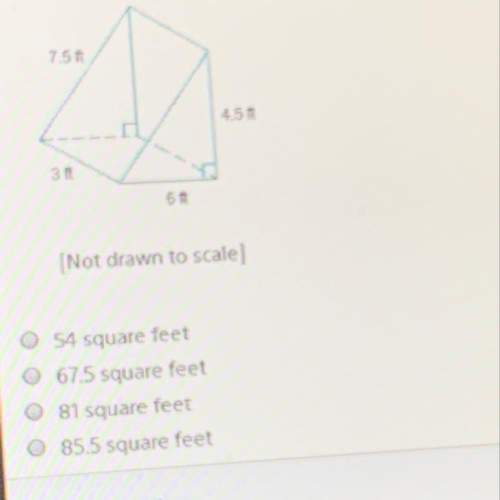
Mathematics, 23.06.2019 17:00 wmaingrette1
Let f(x) = 8/1+3e^-0.7x. what is the value of f(3) round your answer to the nearest hundredth.

Answers: 2


Another question on Mathematics

Mathematics, 21.06.2019 15:20
Abcd ≅ klmn ≅ pqrs ≅ wxyz given that information, which figures are reflections of abcd?
Answers: 1

Mathematics, 21.06.2019 17:00
Asif spent $745.10 on 13 new file cabinets for his office. small file cabinets cost $43.50 and large file cabinets cost $65.95. write and solve a system of equations to find the number of small cabinets and large cabinets he purchased. determine if each statement is true or false. 1. he purchased 5 small cabinets. true or false 2. he purchased 7 large cabinets. true or false 3. he spent $527.60 on large cabinets. true or false
Answers: 2

Mathematics, 21.06.2019 21:00
The description below represents function a and the table represents function b: function a the function is 5 more than 3 times x. function b x y −1 2 0 5 1 8 which statement is correct about the slope and y-intercept of the two functions? (1 point) their slopes are equal but y-intercepts are not equal. their slopes are not equal but y-intercepts are equal. both slopes and y intercepts are equal. neither slopes nor y-intercepts are equal.
Answers: 3

Mathematics, 21.06.2019 21:30
In a test for esp (extrasensory perception), the experimenter looks at cards that are hidden from the subject. each card contains either a star, a circle, a wave, a cross or a square.(five shapes) as the experimenter looks at each of 20 cards in turn, the subject names the shape on the card. when the esp study described above discovers a subject whose performance appears to be better than guessing, the study continues at greater length. the experimenter looks at many cards bearing one of five shapes (star, square, circle, wave, and cross) in an order determined by random numbers. the subject cannot see the experimenter as he looks at each card in turn, in order to avoid any possible nonverbal clues. the answers of a subject who does not have esp should be independent observations, each with probability 1/5 of success. we record 1000 attempts. which of the following assumptions must be met in order to solve this problem? it's reasonable to assume normality 0.8(1000), 0.2(1000)%30 approximately normal 0.8(1000), 0.2(1000)% 10 approximately normal srs it is reasonable to assume the total number of cards is over 10,000 it is reasonable to assume the total number of cards is over 1000
Answers: 1
You know the right answer?
Let f(x) = 8/1+3e^-0.7x. what is the value of f(3) round your answer to the nearest hundredth....
Questions

Mathematics, 19.08.2019 07:30

Physics, 19.08.2019 07:30







History, 19.08.2019 07:30

Mathematics, 19.08.2019 07:30

Mathematics, 19.08.2019 07:30

Mathematics, 19.08.2019 07:30

Biology, 19.08.2019 07:30

Mathematics, 19.08.2019 07:30




Mathematics, 19.08.2019 07:30

Mathematics, 19.08.2019 07:30




